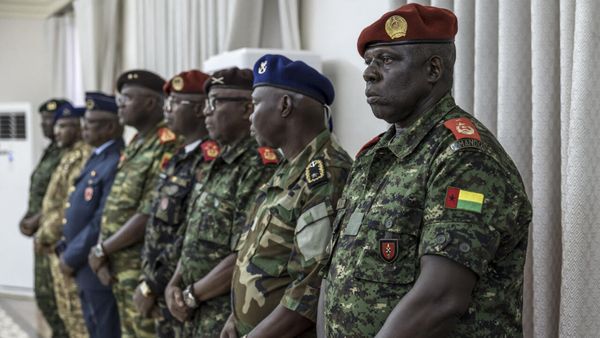The international humanitarian system is in freefall. Following the dramatic funding cuts initiated by Donald Trump’s administration in the United States, deliveries of essential food, medicines and clean water to those in need have halted and stockpiles are dwindling. Aid agencies are scrambling to figure out how to do less with less, even as global needs are mounting.
Read more: The growing threat to U.S. democracy will literally cost lives
Those displaced inside their own countries, as a result of conflict or natural disaster, have been particularly hard hit by this upheaval.
Internally displaced persons already fall through the cracks of the humanitarian system, despite dramatically outnumbering those who cross borders as refugees.
Worldwide, there are an estimated 43.7 million refugees, compared to 83.4 million internally displaced people. Yet media coverage still focuses on those fleeing their country as refugees, while internally displaced people remain less visible and beholden to national governments that have the primary responsibility to assist them.
Some governments, such as Ukraine’s, work hard to meet this challenge but need outside support. In countries like Myanmar and Afghanistan, governments are complicit in displacing their own citizens, necessitating stronger international leadership.
The UN’s central role
The Office of the United Nations High Commissioner for Refugees (UNHCR) was established to protect and assist refugees. But from as early as the 1970s — as a result of calls from the UN General Assembly to address displacement crises — it has also become a leading entity in the international response to internally displaced persons.
Advocacy from the UN Special Rapporteur on Human Rights of Internally Displaced Persons (established in the early 1990s), and more recently from the UN Secretary-General’s High Level Panel on Internally Displaced Persons and the work of the Office of the UN Special Advisor on Solutions to Internal Displacement, has also promoted increased attention to the issue and advocated workable solutions.
This progress is now at risk in the face of U.S. humanitarian aid cuts.
The danger today is not that the UNHCR and other humanitarian leaders will treat internally displaced people as unimportant or undeserving of help. Instead, ground could be lost through a return to the UNHCR’s traditional, narrow refugee mandate. Responsibility for internally displaced persons could be shirked as many UN agencies are also under stress.
This will further increase the marginalization of internally displaced people and expose them to heightened levels of insecurity, poverty and disease.
The UNHCR is far from the only international organization involved with internally displaced persons. The International Organization for Migration is another important player, particularly in natural disasters, and other agencies, including the UN Development Programme, support longer-term development solutions.
Yet the UNHCR is the core protection agency for those who are forcibly displaced and its leadership is critical to ensuring a comprehensive response to both refugees and those displaced within their own country’s borders.
Difficult choices
In the face of a 30 per cent reduction in operating expenses in its headquarters and regional bureaus, the UNHCR faces some agonizing choices. But these cuts must not produce a competition between internally displaced persons and refugees in humanitarian assistance.
Experience has shown that effective responses must consider displacement dynamics not only across but also within borders — especially since many refugees are internally displaced before they seek safety abroad and many face internal displacement if they return to their countries of origin.
The good news is that the UNHCR remains committed to supporting inter-agency co-operation on solutions for internally displaced people, following up on the work of the Office of the UN Special Advisor.
However, the head of the UNHCR has not yet publicly and clearly reaffirmed his agency’s commitment to standing up for internally displaced people alongside refugees in this moment of flux in the humanitarian sector.
The need for strong leadership
As the UNHCR reduces its commitments and shrinks its operations, there could be a void of senior leadership on internal displacement at headquarters and in the field. This means the agency’s response may be determined by regional and country directors with different levels of comfort with and commitment to internally displaced persons.
The irony is that the UNHCR routinely calls for governments dealing with internal displacement crises to clearly allocate responsibility for effective responses. Today’s budget crisis is no excuse for the UNHCR not to walk its own talk.
In the face of declining resources but mounting humanitarian needs, the UNHCR and its donors should prioritize preserving their investment in strengthened, reliable and rights-based responses to internally displaced persons — not only for the sake of these citizens, but also as an integral element of a comprehensive response to refugee situations.
Read more: Ethiopia's war may have ended, but the Tigray crisis hasn't
The UNHCR should recognize and insist that refugee response requires an effective response to those displaced internally and vice versa. As a core part of this approach, the agency should also enhance its support for local efforts led by internally displaced people themselves, recognizing they can be, and have been, at the forefront of more effective solutions to their displacement.
The UNHCR’s funding cuts are putting the agency in a pared-down holding pattern until the next high commissioner of the organization is chosen later this year. A key criterion for selecting the next leader should be their vision for sustaining engagement with internally displaced persons alongside refugees in this moment of global turmoil.
Megan Bradley receives funding from SSHRC.
Jennifer Welsh receives funding from the Social Science and Research Council of Canada and the European Research Council.
This article was originally published on The Conversation. Read the original article.







